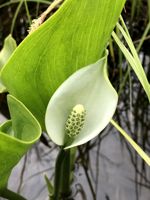Mon-Fri 9am - 5pm Mountain time
White Meadowsweet vs Water Arum
Spiraea alba
Calla palustris
NOT AVAILABLE THIS SEASON - MIGHT RETURN
CUSTOM GROW
White Meadowsweet is a woody, deciduous shrub that begins to bloom in early summer with small white and pink flowers. Its foliage turns from a light green into an attractive golden-yellow later in the fall.
The White Meadowsweet, also known as Mead-Wort or Bride-Wort, is favored by birds and butterflies but is largely ignored by deer. They produce small brown berries in the summer, and while they are technically edible, they are not sweet and are more desired by wildlife.
Water Arum is a native perennial wetland plant known for its showy white oval sheaths (spathe) that surround a yellow-green, cylindrical flower spike (spadix). It has large, oblong, heart-shaped leaves on stems that rise above the water from shallow, spreading rhizomes. The blossoms are followed in late summer by tiny, pear-shaped fruits that ripen to bright red, adding ornamental interest to wet habitats.
Water Arum provides food for birds and small mammals that eat its berries, and its flowers attract pollinators. It can tolerate cold climates and forms colonies in shallow water and saturated soils. It is well-suited for ecological restoration, riparian planting, naturalisation, and habitat projects in wet and shaded environments.
White Meadowsweet Quick Facts
Water Arum Quick Facts
Toxicity: toxic if ingested

